In September of 2022, nearly two years after its launch, OpenAI made their flagship AI image generation platform Dall-E available to the public. Alongside competitors such as Midjourney and Stable Diffusion, Dall-E could generate original images in an endless amount of styles and genres with just a one-line text prompt fed to it by the user. With public discourse already primed by justified concern over deepfakes, artists, writers, and other creatives baulked at the implications: why commission an artwork when you can just ask Dall-E to make it for you with the tap of a few keys?
As an art historian, this pairing of technological innovation and crisis of public morality was familiar to me. It happened with the printing press in the 15th century, and again with photography in the 19th. Who would buy a portrait when you could capture the exact likeness of a person with the technology of a camera? With generative AI, however, this historical precedent was complicated by the technology’s own inherent ability to produce original works with minimal human intervention. Whereas a camera requires lighting, focus, staging, and compositional direction from the artist in order to produce a photo, all Dall-E requires is a sentence to produce wildly variable images. What does this expanded field of creative technologies mean for arts practice of the future?
Enter Helicon, Northwestern University’s on-campus literary magazine. Established nearly 45 years ago by three dedicated poetry students, Helicon is a storied institution of literary and artistic merit representing some of the University’s best creatives. I reached out to the magazine’s editor, Lily Glaubinger, with a proposal: bring the editorial board to the Emerging Technologies Lab for a writing workshop, and see what original works can come from experimenting with this newly accessible technology. How would our writers use Dall-E2? What challenges would they face? How would generative AI influence their writing practice? Our contributors— Ann Gaither, Lily Glaubinger, Natalie Jarrett, Skye Tarshis, and Alivia Wynn— were eager to explore the implications of AI image generation for their own creative practices.

Lily Glaubinger
On a Saturday afternoon in January, Helicon’s editorial board arrived at the Emerging Technologies Lab to use Dall-E2 for the first time. We began with a short discussion of the state of generative AI in the field, a demo of how Dall-E2’s interface worked, and tips on how to tailor a prompt for the best results. We also discussed some of the major pitfalls and ethical concerns of generative AI, ranging from its tendency to depict femme-coded bodies in overtly sexualized ways, to its statistical likelihood of defaulting to white and lighter skin tones. By discussing such obstacles at the beginning of the writing workshop, we flagged such context as critical to our writers’ understanding of the tool at hand. Though generative AI can produce endless variations of images, text, sound, and even video at the simple request of a well-worded prompt, those outcomes are inflected by the biases and blind spots of the coders who build the structures that inform how a generative AI makes decisions. By knowing this from the start, we hoped to encourage our writers to think critically and adaptably about how they used the tool over the course of the workshop.

Ann Gaither
The resulting text-and-image pieces, displayed at the front of the Main Library in Spring Quarter 2023, are as beautiful as they are strange, uncanny as they are familiar, and humorous as they are disturbing. Each writer took a different approach to their use of Dall-E2; some specified clear descriptions with defined aesthetic parameters, while others fed their original prose into Dall-E2’s text box and let chance play out in ones and zeros. Some embraced the absurdity of the resulting images, others made hypotheses about how to produce certain types of images and experimented accordingly. In their exit interviews, almost every writer remarked on both the usefulness of the tool for the ideating process of creative endeavors, and their surprise at the limits of Dall-E2’s scope. The future of generative AI in creative practice and industry continues to take shape; it is our imperative to make sure that shape forms responsibly and ethically.
Though the exhibition has since been deinstalled, the project has been digitally archived in a beautiful web iteration here.
